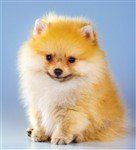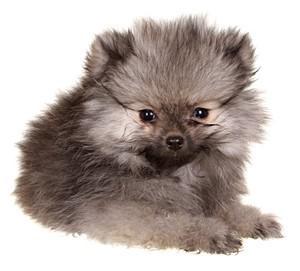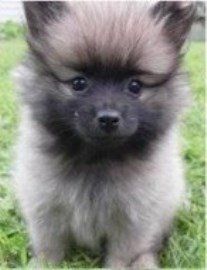Wolf Sable Pomeranians
With most types of sable Poms, there are two parts to the term: the base color and then the 'sable'. For example, cream sable, orange sable and red sable. For each of those coats, cream, orange or red will be the base color.
Then, the sable will be dark tipped hairs. These may cover the entire coat or just some sections. They may be light (just a dusting) or heavy (it will be difficult to see the base color under it). This is important to remember, because with wolf sable Poms, this rule of term = base color + sable does not hold true.
With wolf sables, the term 'wolf' does not
refer to the Pom's base coat. While many will assume that wolf refers to a gray color, it does not in this case. Wolf refers to a very rare gene and we will get into that more in a bit. The sable part of the wolf sable term does, however, refer to dark tipped hairs.
So, what color is a wolf sable Pom? In most cases, the Pom will have a cream coat. If the sabling is light, you will clearly see that color. However, if the sabling is very heavy and it covers just about the entire coat, a wolf sable Pomeranian can appear to be a gray Pom. Do please note that gray is not an accepted coat color per the AKC.
This brings us to the question of, what does a wolf sable Pomeranian look like, if we are saying that he is a cream coat with sable? Well, he will appear to be just that and the only true way of knowing if he is a cream sable or a real wolf sable is via DNA testing (more ahead).
And this is where so much debate comes in. There are breeders
who look at a Pom, decide that he is wolf sable and not only register him as so (the AKC allows a breeder to check off any color that they desire) but also sell the puppy as a wolf sable. Far too many cream and light orange sables are being classified as wolf when they are not. And this really should not be happening.
It is impossible to know, just by looking, that a Pom is wolf sable. This said, breeders who have paired wolf sables together will have a good idea if the resulting litter carries the gene, but again, only DNA testing can confirm this.
In regard to skin pigmentation, wolf sable Pomeranians have black pigmentation; eye rims, nose, lips and paw pads are black.
Sabling
Changes with Sables
In many cases, sabling fades off as a Pomeranian matures. It may completely grow out or simply appear to a lesser degree. This happens during the phase of the
puppy uglies, when the puppy coat falls out and the adult coat grows in. This said, there are some instances of sabling coming in heavier as the pup matures, which is always a nice treat.
Since changes can be quite drastic, a true wolf sable Pom can start off with very little sabling and grow into it or
he can be covered with those dark tipped hairs as a pup but mature into an adult with very little to none.
Identifying a TrueWolf Sable Pomeranian
Identifying a True Wolf Sable Pomeranian
Gizmo, a 3 month old Wolf Sable Pom Puppy.
Photo courtesy of owners: Jason & Candice
While both sire and dam do not need to be wolf sable to produce a wolf sable, one of the does and needs to be paired with a non-sable dog, since sable (ay) is dominant to wolf sable (aw).
Wolf Shaded Sable?
There have been some wolf sable champions and with the first two, there was some debate in regard to the vernacular and actual classification.
In the year 1892, a champion was registered as light sable, black shaded saddle, but was referred to as wolf shaded sable. The 2nd champion to be a wolf sable Pomeranian was actually registered as a fawn and black.
This is due mostly from certain descriptions being eliminated from the breed standard over the course of time and also from the above mentioned coat changes as the dog matures.
You May Also Like:
Sable Pomeranians
- From cream sable to red sable, this amazing coloring can really add depth and dimension.
Red Pomeranians
- A very rare, but beautiful color that is often confused with orange. Much to the surprise of owners, there is often a color change as the pup matures.
Pomeranian Care Tips
- The top 10 most important aspects, for optimal care.




